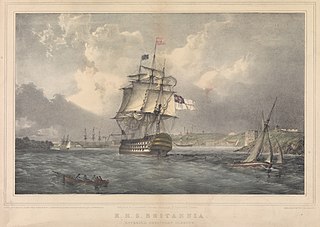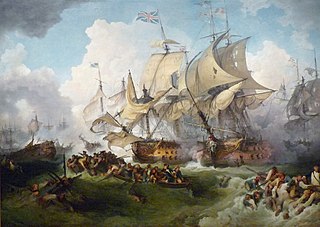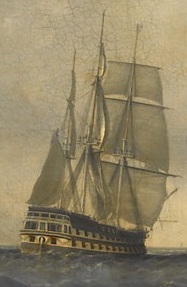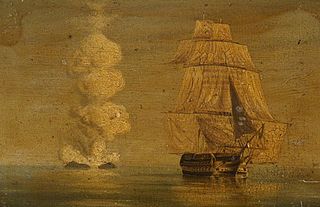
HMS Britannia was a 100-gun first-rate ship of the line of the Royal Navy. The vessel was laid down in 1751 and launched in 1762. Nicknamed Old Ironsides, she served in the American Revolutionary War, the French Revolutionary Wars and the Napoleonic Wars, including at the Battle of Trafalgar in 1805. One of the largest Royal Navy warships of her era, Britannia was one of only three British first-rates present at the battle, alongside HMS Victory and HMS Royal Sovereign. In 1806, the vessel was laid up and eventually converted into a hulk, before being broken up in 1825.

HMS Barfleur was a 90-gun second-rate ship of the line of the Royal Navy, designed by Sir Thomas Slade on the lines of the 100-gun ship Royal William, and launched at Chatham Dockyard on 30 July 1768, at a cost of £49,222. In about 1780, she had another eight guns added to her quarterdeck, making her a 98-gun ship; she possessed a crew of approximately 750. Her design class sisters were the Prince George, Princess Royal, and Formidable. She was a ship of long service and many battles.

Admiral Sir Robert Stopford was a Royal Navy officer and politician whose career spanned over 60 years, from the French Revolutionary Wars to the Egyptian–Ottoman War.

HMS Royal George was a 100-gun first rate ship of the line of the Royal Navy, launched from Chatham Dockyard on 16 September 1788. She was designed by Sir Edward Hunt, and Queen Charlotte was the only other ship built to her draught. She was the fifth ship of the Royal Navy to bear the name.

HMS Pique was a wooden fifth-rate sailing frigate of the Royal Navy, designed by Sir William Symonds. She was launched on 21 July 1834 at Devonport. The vessel was of 1,633 tons burthen and had 36 guns. She was broken up in 1910.

HMS Queen Charlotte was a 100-gun first-rate ship of the line of the Royal Navy, launched on 15 April 1790 at Chatham. She was built to the draught of Royal George designed by Sir Edward Hunt, though with a modified armament.

HMS Boyne was a 98-gun second rate ship of the line of the Royal Navy, built by Nicholas Diddams at Portsmouth Dockyard and launched on 3 July 1810 at Portsmouth. On 12 February 1814 she took part with HMS Caledonia in a hot action against the French line-of-battle ship Romulus off Toulon; the French 74 managed to escape to Toulon by sailing close to the coast to avoid being surrounded. With the 1817 changes to the rating system Boyne was rerated as a 104-gun first rate ship.

HMS Warspite was a 74-gun third-rate ship of the line of the Royal Navy, launched in 1807. She served in the Napoleonic Wars and was decommissioned in 1815. She was re-rated as a 76-gun ship in 1817 and then circumnavigated the world from 1826 to 1827, visiting Australia. She was cut down to a single decker 50-gun frigate in 1840 and was decommissioned in 1846. She was lent as a boys' training ship to the Marine Society and was lost to fire in 1876.
HMS Spencer was a 74-gun third-rate ship of the line of the Royal Navy, launched on 10 May 1800 at Bucklers Hard. Her designer was the French émigré shipwright Jean-Louis Barrallier. She served in two major battles, Algeciras Bay and San Domingo, and in a number of other campaigns. She was broken up in 1822.

HMS Waterloo was an 80-gun third-rate ship of the line, launched on 16 October 1818 at Portsmouth. She was designed by Henry Peake, and built by Nicholas Diddams at Portsmouth Dockyard and was the only ship built to her draught. She had originally been ordered as HMS Talavera, but was renamed on the stocks after the Battle of Waterloo.

HMS Edinburgh was a 74-gun third rate ship of the line of the Royal Navy, launched on 26 November 1811 at Rotherhithe.

HMS Dublin was a 74-gun third rate ship of the line of the Royal Navy, launched on 13 February 1812 at Rotherhithe.

HMS Calcutta was an 84-gun second-rate ship-of-the-line of the Royal Navy, built in teak to a draught by Sir Robert Seppings and launched on 14 March 1831 in Bombay. She was the only ship ever built to her draught. She carried her complement of smooth-bore, muzzle-loading guns on two gundecks. Her complement was 720 men.

HMS Vindictive was a 74-gun third-rate ship of the line of the Royal Navy, built by Nicholas Diddams at Portsmouth Dockyard and launched on 30 November 1813 at Portsmouth.

HMS Royal Sovereign was a 100-gun first rate ship of the line of the Royal Navy, built at Woolwich Dockyard and launched in July 1701. She had been built using some of the salvageable timbers from the previous Royal Sovereign, which had been destroyed by fire in 1697.

HMS Wellesley was a 74-gun third rate, named after the Duke of Wellington, and launched in 1815. She captured Karachi for the British, and participated in the First Opium War, which resulted in Britain gaining control of Hong Kong. Thereafter she served primarily as a training ship before gaining the distinction of being the last British ship of the line to be sunk by enemy action and the only one to have been sunk by an air-raid.

HMS Melville was a 74-gun third rate ship of the line of the Royal Navy, launched on 17 February 1817 at Bombay Dockyard.

HMS Powerful was an 84-gun second rate ship of the line of the Royal Navy, launched on 19 May 1825 at Chatham Dockyard.

The Prince Royal was a 55-gun royal ship of the English Royal Navy. It was later rebuilt and renamed HMS Resolution.

HMS Exmouth was a 91-gun screw-propelled Albion-class second-rate ship of the line of the Royal Navy.




















